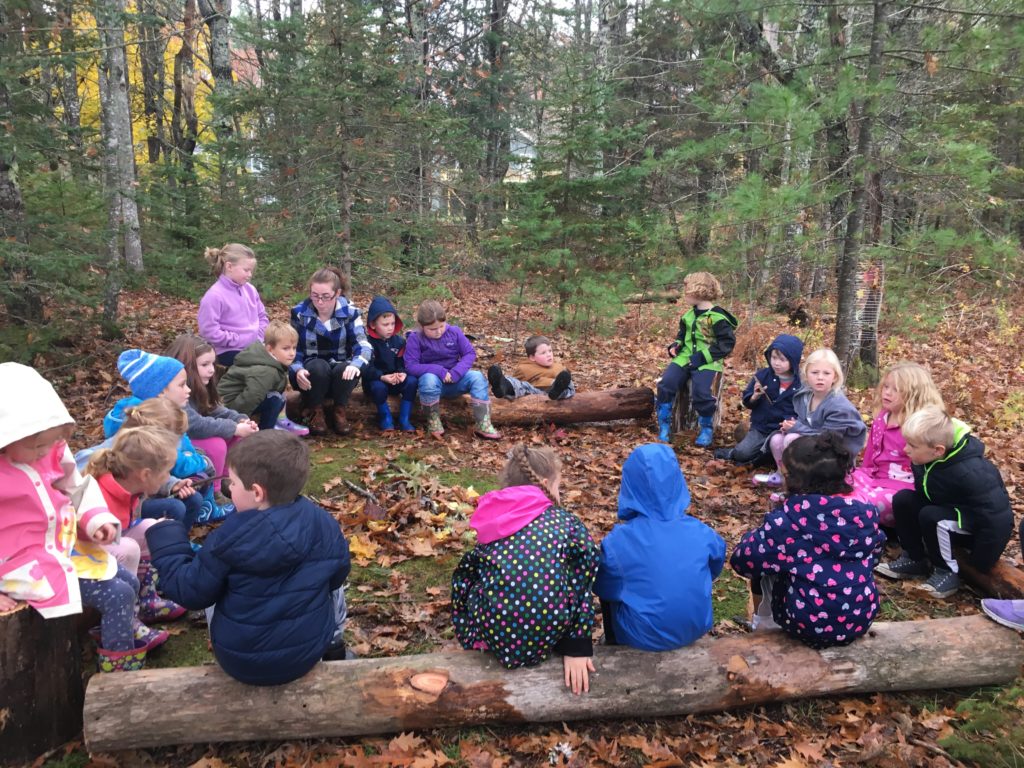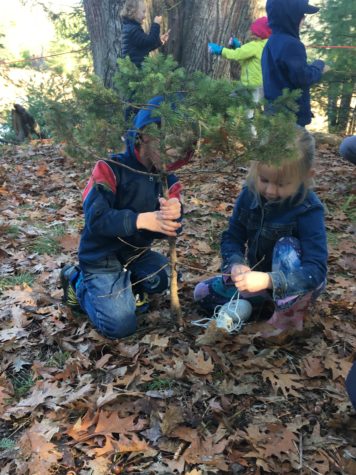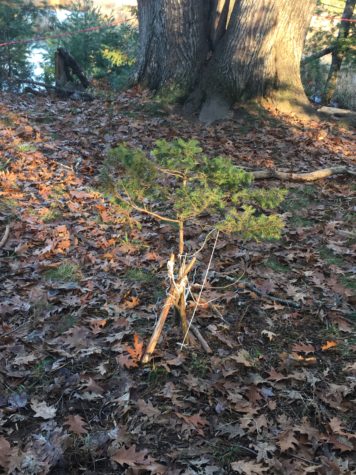 Introduction to Forest Days Program:
Introduction to Forest Days Program:
Forest Days is a new program that BHHT is piloting at the Surry Elementary School for the 2019-2020 school year. We are working with Kindergarten and First Grade for 1-2 hours every week all year long, building resilience in changing weather and relationships with each other and the natural world.
Relationships are at the heart of this approach. The 3 agreements that we discuss and take seriously each session are: “take care of yourself, take care of each other, and take care of the forest.” The curriculum is emergent, which means it is led by participant’s curiosity and wonder, and appropriate and supervised risk taking is encouraged to build confidence and skill. Play, exploration, and movement are central to learning and so is emotional and social development. The program strives to provide a space to improve the wellbeing of the participants and the environment.
Stories and Reflections from Forest Days:
Forest Days is a new program, but kinship with and connections to and within the natural world, are not new to the children, to humans, or to the ecosystems of the world. I see relationships forming each time we enter the forest to play and explore. Forest Days provides a window into re-remembering relationships with the land and other living things, not an introduction of something new.
Already at Surry School so many examples of the (innate?) kinship that children seem to feel with the natural world have surfaced during our time in the woods: taking care of a baby slug that they find on a leaf, trying to help a young red spruce tree stand up again, or building fairy houses to help the fairies keep dry in the rain. There is a lot of love and tenderness that children have for the outdoors, for bugs and trees and spirits, that are worth learning from and cultivating beyond early childhood.
at Surry School so many examples of the (innate?) kinship that children seem to feel with the natural world have surfaced during our time in the woods: taking care of a baby slug that they find on a leaf, trying to help a young red spruce tree stand up again, or building fairy houses to help the fairies keep dry in the rain. There is a lot of love and tenderness that children have for the outdoors, for bugs and trees and spirits, that are worth learning from and cultivating beyond early childhood.
The first time that we took the kindergarteners out to the forest this fall, several of them immediately ran up to a tiny red spruce tree that had fallen over in the clearing near Patten Stream. They were visibly and audible sad. I learned later from them that they used to hold hands and sing around this little tree on their weekly excursions to the woods in their Montessori-based pre-K. Several of them rallied around the tree and brainstormed ways to help it stand back up. By the end of the day it was propped up by a stick looking happier than it had in a long time.
The next time we want out to the forest the red spruce tree had fallen down again. About half way through the session I noticed one boy bent over the tree that was sprawled on the ground, its trunk partly severed from its roots but still connected. The needles were green; life was apparently still there. This one child must have thought so as he lifted the small tree and stood it upright looking around as if to problem solve how to keep it that way. I approached and asked if he was trying to save the tree. He exclaimed in animated tones that he was and it was important since he knew this tree in pre-K. I offered a ball of string from my backpack and before long a crew of his friends had appeared and were helping him wind string around the trunk of the red spruce. Because the tiny tree was in a small clearing they decided it was necessary to wrap the string around various structures further away to hold up the tree (including the seat stumps in our circle and the giant oak tree near the stream). There was string everywhere crisscrossing high and low, around stumps and trees (and children) all in a dedicated, animated effort to save this little spruce tree. Several of the children were managing the string and several were next to the tree trying to prop it up with additional support of sticks. I offered some y-shaped ones and showed them how to use the v shape to cradle the trunk. At one point, the boy returned to the tree from where he was wrapping string around the giant oak and I overheard him say, “Don’t worry little guy we’ll have you feeling better by dinner time.” If all of us spent some of our “play time” connecting on this level with other nonhuman living things, imagine what conservation would look like then!
were green; life was apparently still there. This one child must have thought so as he lifted the small tree and stood it upright looking around as if to problem solve how to keep it that way. I approached and asked if he was trying to save the tree. He exclaimed in animated tones that he was and it was important since he knew this tree in pre-K. I offered a ball of string from my backpack and before long a crew of his friends had appeared and were helping him wind string around the trunk of the red spruce. Because the tiny tree was in a small clearing they decided it was necessary to wrap the string around various structures further away to hold up the tree (including the seat stumps in our circle and the giant oak tree near the stream). There was string everywhere crisscrossing high and low, around stumps and trees (and children) all in a dedicated, animated effort to save this little spruce tree. Several of the children were managing the string and several were next to the tree trying to prop it up with additional support of sticks. I offered some y-shaped ones and showed them how to use the v shape to cradle the trunk. At one point, the boy returned to the tree from where he was wrapping string around the giant oak and I overheard him say, “Don’t worry little guy we’ll have you feeling better by dinner time.” If all of us spent some of our “play time” connecting on this level with other nonhuman living things, imagine what conservation would look like then!
A favorite new quote of mine says it all, “if given the chance, children will show us how our spirits can both nurture and be nurtured by our place” (Natural Curiosity: The Importance of Indigenous Perspectives in Environmental Inquiry, 2014).
If children already possess this inclination to help other living things, how do we help them hold onto it? I did not create the activity of rescuing the tree for the class as a way to practice or be involved in stewardship or forest management. They created it themselves; they remembered this tree from pre-k and were devastated it had fallen, and decided to do something about it. It wasn’t me coming in and saying “ok everyone we are going to save this tree to help our planet, because this is what we do in environmental education programs!” It wasn’t that at all – it was not top-down in any way. I had been told by the school principal that the pre-K would come out to this forest on a pretty regular basis, but I had no idea the extent of their relationship with this place. They showed me and us all, that they loved this place, that they remembered individual trees. Could they identify the species? No. Did they remember the tree and want to help it? Yes. I think this makes a point that good environmental education is not always about identification and memorization of information; good environmental education is allowing children to develop a relationship with a tree, with a forest, with a place, that they eventually want to take care of. David Sobel, professor, environmental educator, and writer, says, “To raise a generation with both the knowledge and the commitment to halt and reverse the rapid denigration of the Earth, we need children who have first come to care about it” (Childhood and Nature, Design Principals for Educators, 2008). This takes commitment on the part of educators, parents, and society as a whole – because it takes time and returning again and again to the forest (or other outdoor space). This is what the Pre-k teacher at Surry Elementary School did, and I am seeing the results of this one -two years later. Forest Days is trying to continue that legacy. 
I took down the string at the end of the day that was slung across the small patch of forest surrounding the red spruce. The sticks holding up the tree I didn’t touch and some of the string was left behind as well. Later I felt badly that I hadn’t asked the children’s permission to remove the string and all the hard work they had put into saving their little tree. I knew I couldn’t leave an entire ball of string, like a massive cobweb, in the forest for a week where other classes might visit for field trips. I also knew that “leave no trace” forbid me to leave it up. Yet, I felt really guilty – until I realized, I am practicing one of the agreements we have at Forest Days: take care of the forest. We have agreed to not only take care of individual trees, but the forest community as a whole. Leaving string where animals could trip on it, birds could ingest it, wind could take it into the stream where it could strangle the fish, would not be taking care of the forest as a whole. This is how I will frame our discussion when the children find the string gone next time they visit the forest! With so much care in their hearts for this one little lopsided spruce tree, they will understand, I have no doubt, and they will find another creative way to keep their spruce tree standing.
Someone asked me when I returned at the end of the day, will that string and those y-shaped sticks really help the tree survive – will this really work? Honestly, I don’t know. That’s not really the point though. The point is that the children care. And they are not going to stop caring if it doesn’t live, they will just keep trying and the more they build relationships, the harder they will try. And eventually, something will work. I believe they will keep trying until it does. Because that’s what you do when you are in a relationship with something that you love, right? You never give up. And I think that’s what’s important. The tree doesn’t have to live for this experience to be hugely significant for the children and all of us. I would love it if the tree did survive, but this is more about the bigger picture. The point is not to get to a successful “final product” of a tree that survives, it is about providing space for children to continue to grow their muscle of caring for the natural world for the long term.
What I love and find fascinating about this experience with the kindergarteners is that it was not inspired or managed by the adults in any significant way. I offered the string, I suggested y-shaped sticks, and then let them go wild in their experimenting and care. Even in all of the pulling, winding, tugging, tangling, (occasional fighting), never once did the tree fall down or be pulled entirely from it roots. The tree was literally and figuratively the center of their attention and purpose for the time, energy, and resources employed during their “play time” in the forest that November afternoon.
So one of our agreements is: take care of the forest. For this new program, I have been brainstorming how I can guide students in learning how to do this. What I learned after observing the tree rescue is that children are natural caretakers of other living things. Provide the space for them to be who they are, to engage with the natural world on a regular basis so that relationships can be built, and offer a few tools or ideas, and then stand back and watch. They will have everything set right in the world by dinner time if we loosen our grip and let them bring magic back into our lives. I firmly believe that as adults we have much to learn from kindergarteners (and tiny spruce trees)!

By Landere Naisbitt, Outreach Coordinator